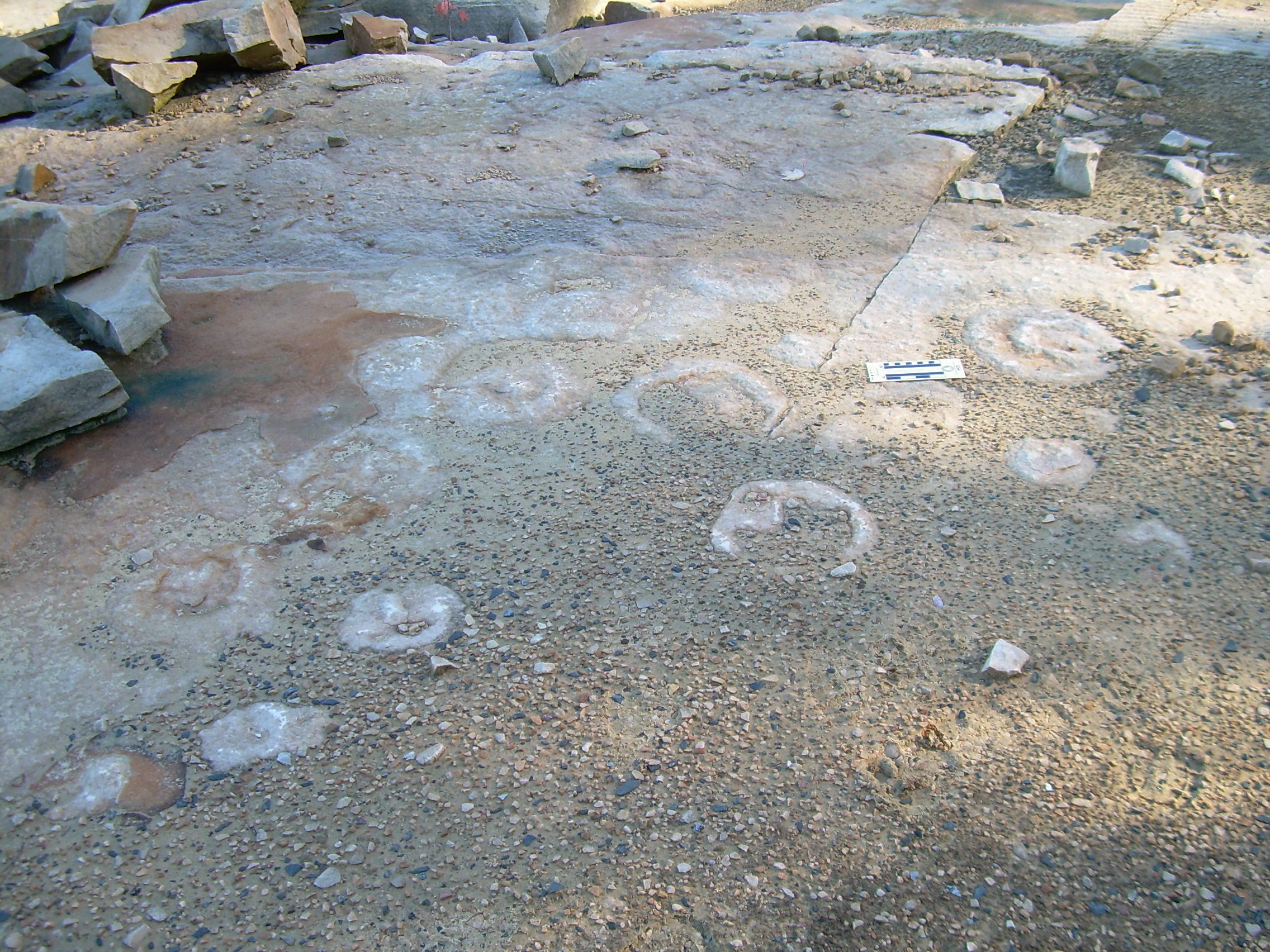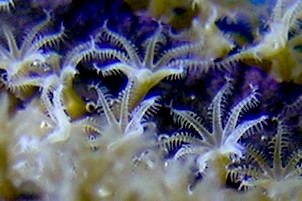|
Strobila
Strobilisation or transverse fission is a form of asexual reproduction consisting of the spontaneous transverse segmentation of the body. It is observed in certain cnidarians and helminths. This mode of reproduction is characterized by high offspring output, which, in the case of the parasitic tapeworms, is of great significance. Strobilation in cnidarians *The process starts with preliminary morphological changes. In particular, the cnidarian's tentacles tend to be reabsorbed. *Neck-formation: transverse constrictions appear near the upper extremity of the animal. A strobilating polyp is called a strobila while the non-strobilating polyp is called a scyphistoma or scyphopolyp. *Segmentation: the number of constriction sites increases and migrates down the body length, transforming the body into a sequence of disks. The fissures intensify until the initial body is divided into equally spaced, separate segments. The oral end of the polyp becomes the oral end of the ephyra. *Metamorp ... [...More Info...] [...Related Items...] OR: [Wikipedia] [Google] [Baidu] |
Medusa (biology)
Jellyfish and sea jellies are the informal common names given to the medusa-phase of certain gelatinous members of the subphylum Medusozoa, a major part of the phylum Cnidaria. Jellyfish are mainly free-swimming marine animals with umbrella-shaped bells and trailing tentacles, although a few are anchored to the seabed by stalks rather than being mobile. The bell can pulsate to provide propulsion for highly efficient locomotion. The tentacles are armed with stinging cells and may be used to capture prey and defend against predators. Jellyfish have a complex life cycle; the medusa is normally the sexual phase, which produces planula larvae that disperse widely and enter a sedentary polyp phase before reaching sexual maturity. Jellyfish are found all over the world, from surface waters to the deep sea. Scyphozoans (the "true jellyfish") are exclusively marine, but some hydrozoans with a similar appearance live in freshwater. Large, often colorful, jellyfish are common in c ... [...More Info...] [...Related Items...] OR: [Wikipedia] [Google] [Baidu] |
Nausithoe Aurea
''Nausithoe aurea'', also known as the ''Nausithoe maculata'', is a species of crown jellyfish found off the southeastern coast of Brazil. The central disc has been measured to be 10.5 mm. ''N. aurea'' is transparent with yellow and brown spots located around the gonads. ''N. aurea'' can reproduce either asexually by strobilation Strobilisation or transverse fission is a form of asexual reproduction consisting of the spontaneous transverse segmentation of the body. It is observed in certain cnidarians and helminths. This mode of reproduction is characterized by high offspr ... or sexually. Either ephyrae or planuloids may be produced by strobilation; only ephyrae can produce the medusal form. Strobilation can be induced to occur when food is abundant. In polyps, a large availability of food leads to strobilation if it is not regulated. ''N. aurea'' species usually take more than 20 weeks to begin the differentiation and development of reproductive organs. References ... [...More Info...] [...Related Items...] OR: [Wikipedia] [Google] [Baidu] |
Cnidarian
Cnidaria () is a phylum under kingdom Animalia containing over 11,000 species of aquatic animals found both in Fresh water, freshwater and Marine habitats, marine environments, predominantly the latter. Their distinguishing feature is cnidocytes, specialized cells that they use mainly for capturing prey. Their bodies consist of mesoglea, a non-living jelly-like substance, sandwiched between two layers of epithelium that are mostly one cell (biology), cell thick. Cnidarians mostly have two basic body forms: swimming Medusa (biology), medusae and Sessility (motility), sessile polyp (zoology), polyps, both of which are Symmetry (biology)#Radial symmetry, radially symmetrical with mouths surrounded by tentacles that bear cnidocytes. Both forms have a single Body orifice, orifice and body cavity that are used for digestion and respiration (physiology), respiration. Many cnidarian species produce Colony (biology), colonies that are single organisms composed of medusa-like or polyp (z ... [...More Info...] [...Related Items...] OR: [Wikipedia] [Google] [Baidu] |
Proglottid
Cestoda is a Class (biology), class of parasitic worms in the flatworm phylum (Platyhelminthes). Most of the species—and the best-known—are those in the subclass Eucestoda; they are ribbon-like worms as adults, known as tapeworms. Their bodies consist of many similar units known as proglottids—essentially packages of eggs which are regularly shed into the environment to infect other organisms. Species of the other subclass, Cestodaria, are mainly fish infecting parasites. All cestodes are parasitism, parasitic; many have complex Life history theory, life histories, including a stage in a Host (biology)#Definitive and secondary hosts, definitive (main) host in which the adults grow and reproduce, often for years, and one or two intermediate stages in which the larvae develop in other hosts. Typically the adults live in the digestive tracts of vertebrates, while the larvae often live in the bodies of other animals, either vertebrates or invertebrates. For example, ''Diphyllob ... [...More Info...] [...Related Items...] OR: [Wikipedia] [Google] [Baidu] |
Jellyfish
Jellyfish and sea jellies are the informal common names given to the medusa-phase of certain gelatinous members of the subphylum Medusozoa, a major part of the phylum Cnidaria. Jellyfish are mainly free-swimming marine animals with umbrella-shaped bells and trailing tentacles, although a few are anchored to the seabed by stalks rather than being mobile. The bell can pulsate to provide propulsion for highly efficient animal locomotion, locomotion. The tentacles are armed with Cnidocyte, stinging cells and may be used to capture prey and defend against predators. Jellyfish have a complex Biological life cycle, life cycle; the medusa is normally the sexual phase, which produces planula larvae that disperse widely and enter a sedentary polyp (zoology), polyp phase before reaching sexual maturity. Jellyfish are found all over the world, from surface waters to the deep sea. Scyphozoans (the "true jellyfish") are exclusively marine habitats, marine, but some hydrozoans with a simila ... [...More Info...] [...Related Items...] OR: [Wikipedia] [Google] [Baidu] |
Scyphozoa
The Scyphozoa are an exclusively marine class of the phylum Cnidaria, referred to as the true jellyfish (or "true jellies"). The class name Scyphozoa comes from the Greek word '' skyphos'' (), denoting a kind of drinking cup and alluding to the cup shape of the organism. Scyphozoans have existed from the earliest Cambrian to the present. Biology Most species of Scyphozoa have two life-history phases, including the planktonic medusa or polyp form, which is most evident in the warm summer months, and an inconspicuous, but longer-lived, bottom-dwelling polyp, which seasonally gives rise to new medusae. Most of the large, often colorful, and conspicuous jellyfish found in coastal waters throughout the world are Scyphozoa. They typically range from in diameter, but the largest species, '' Cyanea capillata'' can reach across. Scyphomedusae are found throughout the world's oceans, from the surface to great depths; no Scyphozoa occur in freshwater (or on land). As medusae, they eat ... [...More Info...] [...Related Items...] OR: [Wikipedia] [Google] [Baidu] |
Polyp (zoology)
A polyp in zoology Zoology ()The pronunciation of zoology as is usually regarded as nonstandard, though it is not uncommon. is the branch of biology that studies the animal kingdom, including the structure, embryology, evolution, classification, habits, and ... is one of two forms found in the phylum Cnidaria, the other being the medusa (biology), medusa. Polyps are roughly cylindrical in shape and elongated at the axis of the vase-shaped body. In solitary polyps, the aboral (opposite to oral) end is attached to the substrate (biology), substrate by means of a disc-like holdfast (biology), holdfast called a pedal disc, while in colony (biology), colonies of polyps it is connected to other polyps, either directly or indirectly. The oral end contains the mouth, and is surrounded by a circlet of tentacles. Classes In the class (biology), class Anthozoa, comprising the sea anemones and corals, the individual is always a polyp; in the class Hydrozoa, however, the indi ... [...More Info...] [...Related Items...] OR: [Wikipedia] [Google] [Baidu] |
Moon Jellyfish
''Aurelia aurita'' (also called the common jellyfish, moon jellyfish, moon jelly or saucer jelly) is a species of the genus '' Aurelia''. All species in the genus are very similar, and it is difficult to identify ''Aurelia'' medusae without genetic sampling; most of what follows applies equally to all species of the genus. The most common method used to identify the species consists of selecting a jellyfish from a harbour using a device, usually a drinking glass and then photographing the subject. This means that they can be released in to the harbour shortly afterwards and return to their natural habitat. The jellyfish is almost entirely translucent, usually about in diameter, and can be recognized by its four horseshoe-shaped gonads, easily seen through the top of the bell. It feeds by collecting medusae, plankton, and mollusks with its tentacles, and bringing them into its body for digestion. It is capable of only limited motion, and drifts with the current, even when swimming ... [...More Info...] [...Related Items...] OR: [Wikipedia] [Google] [Baidu] |
Feces
Feces ( or faeces), known colloquially and in slang as poo and poop, are the solid or semi-solid remains of food that was not digested in the small intestine, and has been broken down by bacteria in the large intestine. Feces contain a relatively small amount of metabolic waste products such as bacterially altered bilirubin, and dead epithelial cells from the lining of the gut. Feces are discharged through the anus or cloaca during defecation. Feces can be used as fertilizer or soil conditioner in agriculture. They can also be burned as fuel or dried and used for construction. Some medicinal uses have been found. In the case of human feces, fecal transplants or fecal bacteriotherapy are in use. Urine and feces together are called excreta. Skatole is the principal compound responsible for the unpleasant smell of feces. Characteristics The distinctive odor of feces is due to skatole, and thiols (sulfur-containing compounds), as well as amines and carboxylic aci ... [...More Info...] [...Related Items...] OR: [Wikipedia] [Google] [Baidu] |
Iodine
Iodine is a chemical element with the Symbol (chemistry), symbol I and atomic number 53. The heaviest of the stable halogens, it exists as a semi-lustrous, non-metallic solid at standard conditions that melts to form a deep violet liquid at , and boils to a violet gas at . The element was discovered by the French chemist Bernard Courtois in 1811 and was named two years later by Joseph Louis Gay-Lussac, after the Ancient Greek 'violet-coloured'. Iodine occurs in many oxidation states, including iodide (I−), iodate (), and the various periodate anions. It is the least abundant of the stable halogens, being the sixty-first most abundant element. As the heaviest essential mineral nutrient, iodine is required for the synthesis of thyroid hormones. Iodine deficiency affects about two billion people and is the leading preventable cause of intellectual disabilities. The dominant producers of iodine today are Chile and Japan. Due to its high atomic number and ease of attachment to ... [...More Info...] [...Related Items...] OR: [Wikipedia] [Google] [Baidu] |






